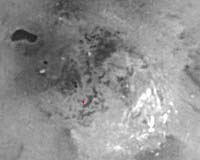|
|
|
Saturn Moon Could Power 150 Billion Labor Day Barbecues Pasadena CA (SPX) Sep 08, 2009  Since its discovery by Dutch astronomer Christiaan Huygens in 1655, Saturn's most massive moon, Titan, has been known as a place of mystery and intrigue. The large, cloud-enshrouded moon is such a scientific enigma that for the past five years, it has been targeted by NASAs Cassini spacecraft with more than 60 probing flybys. One of its latest findings could be a valuable asset to future ... read more
Since its discovery by Dutch astronomer Christiaan Huygens in 1655, Saturn's most massive moon, Titan, has been known as a place of mystery and intrigue. The large, cloud-enshrouded moon is such a scientific enigma that for the past five years, it has been targeted by NASAs Cassini spacecraft with more than 60 probing flybys. One of its latest findings could be a valuable asset to future ... read more'Heat Stroke' Caused India's Lunar Probe To Fail  New Delhi, India (RIA Novosti) Sep 08, 2009
New Delhi, India (RIA Novosti) Sep 08, 2009India's first lunar mission may have failed as a result of overheating, a national daily reported on Monday. Chandrayaan-1 was launched in October 2008 and its main mission was conducting geological mapping of the Moon's surface aimed at producing a complete map of the chemical characteristics and 3-D topography. Chandrayaan means Moon Craft in Sanskrit. According to The Times of ... more
|
Vietnam says parched Red River at record low
China to be world's third biggest wind power producer: media Cost-cutting NASA eyes three cheap space missions Honduras declares state of emergency amid drought Russia in secret plan to save Earth from asteroid: official Sarkozy scrambles to salvage carbon tax French carbon tax ruled illegal Brazil's Lula signs law cutting CO2 emissions 2009 a 'benign' year of natural disasters: German re-insurer Greenpeace Spain demands Denmark release its director
| |||||||||||||||
| Previous Issues | Sep 07 | Sep 03 | Sep 02 | Sep 01 |
| . |
Scientist Rubbishes Apollo 15 Conspiracy Theory Delhi, India (PTI) Sep 04, 2009
Delhi, India (PTI) Sep 04, 2009A Camera on board India's maiden unmanned lunar mission Chandrayaan-1 has recorded images of the landing site of US spacecraft Apollo 15, a scientist said today, rubbishing conspiracy theories that the fourth US mission to land on the moon four decades back was a hoax. The Terrain mapper camera (TMC) on board Chandrayaan-1, which had an abrupt end a few days back, has sent the prints of ... more Indian satellite confirmed US moon landing: scientist  Panaji, India (AFP) Sept 2, 2009
Panaji, India (AFP) Sept 2, 2009India's first lunar mission has captured images of the landing site of the Apollo 15 craft, debunking theories that the US mission was a hoax, the country's state-run space agency said Wednesday. "The images captured by a hyper-spectral camera fitted as a part of Chandrayaan-I... has reconfirmed the veracity of the Apollo 15 mission," said Prakash Chauhan, from the Indian Space Research Orga ... more Chandrayaan-1 Confirms Lunar Magma Ocean Hypo  Panaji, India (PTI) Sep 03, 2009
Panaji, India (PTI) Sep 03, 2009India's maiden moon mission, Chandrayaan-1, in one of its vital findings, has endorsed the lunar magma ocean hypothesis, helping the scientists better understand the history of the satellite, a NASA scientist said here today. Speaking at an international conference here, Carle Pieters, a professor at the US-based Brown University, who was associated with the Chandrayaan as a moon mineral m ... more |
. |
| . |
The 40-Year-Old Dream Tucson AZ (SPX) Aug 26, 2009
Tucson AZ (SPX) Aug 26, 2009It's time to find out if humans can permanently live and work in space, according to an article written by Mark Sykes and published in the Arizona Daily Star, Tucson, Arizona's morning newspaper. "This has never been a part of U.S. space policy, despite a long history of public relations implying the opposite," Sykes says. Sykes, CEO and director of the Tucson-based Planetary Science ... more The Ultimate Long Distance Communication  White Sands NM (SPX) Aug 20, 2009
White Sands NM (SPX) Aug 20, 2009Anyone who's vacationed in the mountains or lived on a farm knows that it's hard to get good internet access or a strong cell phone signal in a remote area. Communicating across great distances has always been a challenge. So when NASA engineers designed the Lunar Reconnaissance Orbiter (LRO), they knew it would need an extraordinary communications system. Over the next year, the LRO, NASA ... more Microsats For The Moon  Sydney, Australia (SPX) Aug 20, 2009
Sydney, Australia (SPX) Aug 20, 2009For decades, microsatellites have been a boon to spaceflight. A small satellite can be built and launched fairly cheaply, sometimes hitching a ride for free aboard a large satellite launch. So far, microsatellites have not ventured very far into space. Could one go all the way to the Moon? Amateur groups have speculated on this possibility for years, but none have actually built a bird and ... more |
. |
| Previous Issues | Sep 07 | Sep 03 | Sep 02 | Sep 01 |
| The contents herein, unless otherwise known to be public domain, are Copyright 1995-2009 - SpaceDaily. AFP and UPI Wire Stories are copyright Agence France-Presse and United Press International. ESA Portal Reports are copyright European Space Agency. All NASA sourced material is public domain. Additional copyrights may apply in whole or part to other bona fide parties. Advertising does not imply endorsement, agreement or approval of any opinions, statements or information provided by SpaceDaily on any web page published or hosted by SpaceDaily. Privacy statement |